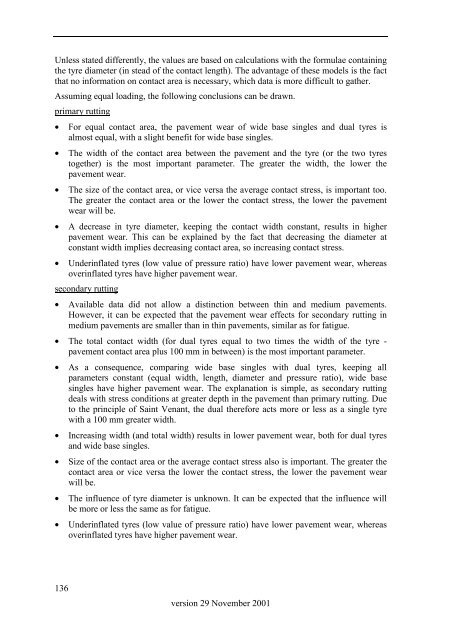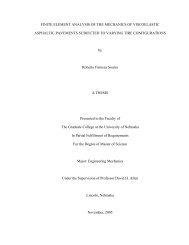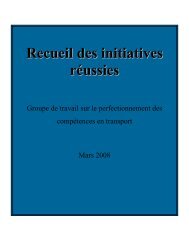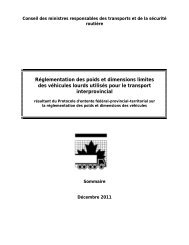Create successful ePaper yourself
Turn your PDF publications into a flip-book with our unique Google optimized e-Paper software.
Unless stated differently, the values are based on calculations with the formulae containingthe tyre diameter (in stead of the contact length). The advantage of these models is the factthat no information on contact area is necessary, which data is more difficult to gather.Assuming equal loading, the following conclusions can be drawn.primary rutting• For equal contact area, the pavement wear of wide base singles and dual tyres isalmost equal, with a slight benefit for wide base singles.• The width of the contact area between the pavement and the tyre (or the two tyrestogether) is the most important parameter. The greater the width, the lower thepavement wear.• The size of the contact area, or vice versa the average contact stress, is important too.The greater the contact area or the lower the contact stress, the lower the pavementwear will be.• A decrease in tyre diameter, keeping the contact width constant, results in higherpavement wear. This can be explained by the fact that decreasing the diameter atconstant width implies decreasing contact area, so increasing contact stress.• Underinflated tyres (low value of pressure ratio) have lower pavement wear, whereasoverinflated tyres have higher pavement wear.secondary rutting• Available data did not allow a distinction between thin and medium pavements.However, it can be expected that the pavement wear effects for secondary rutting inmedium pavements are smaller than in thin pavements, similar as for fatigue.• The total contact width (for dual tyres equal to two times the width of the tyre -pavement contact area plus 100 mm in between) is the most important parameter.• As a consequence, comparing wide base singles with dual tyres, keeping allparameters constant (equal width, length, diameter and pressure ratio), wide basesingles have higher pavement wear. The explanation is simple, as secondary ruttingdeals with stress conditions at greater depth in the pavement than primary rutting. Dueto the principle of Saint Venant, the dual therefore acts more or less as a single tyrewith a 100 mm greater width.• Increasing width (and total width) results in lower pavement wear, both for dual tyresand wide base singles.• Size of the contact area or the average contact stress also is important. The greater thecontact area or vice versa the lower the contact stress, the lower the pavement wearwill be.• The influence of tyre diameter is unknown. It can be expected that the influence willbe more or less the same as for fatigue.• Underinflated tyres (low value of pressure ratio) have lower pavement wear, whereasoverinflated tyres have higher pavement wear.136version 29 November 2001






